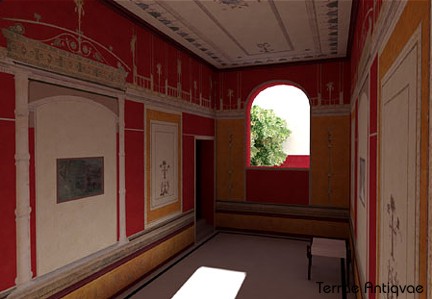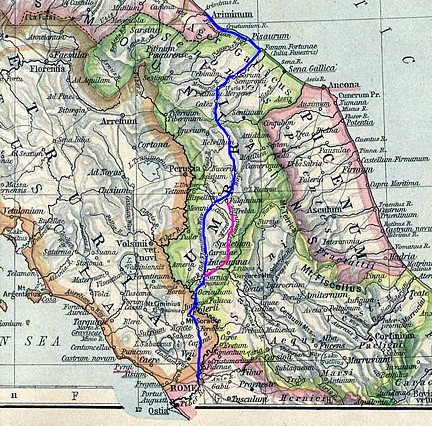Recrean virtualmente las vías que partían de Roma con sus monumentos, villas, y personajes ilustres
Un museo dio a conocer el martes una reconstrucción virtual de las antiguas vías que partían de Roma, permitiendo al visitante ver monumentos reconstruidos y tener una participación interactiva con la elite política municipal.
El proyecto crea personajes o encarnaciones que transitan por la antigua Vía Flaminia, y exploran los monumentos funerarios que jalonan el camino, puentes y arcos. Pueden además recorrer la villa que perteneció a Livia, la esposa del primer emperador romano, Augusto.
Las encarnaciones pueden igualmente ser alteradas entre el esplendor de la antigua Roma y un recorrido virtual de los monumentos tal y como aparecen hoy: ruinas frágiles en las afueras de la capital italiana.
De esta forma, el proyecto permite el acceso a lugares inaccesibles para la mayoría de los turistas, difíciles de visitar o rodeados por el tránsito de la moderna Vía Flaminia, que con frecuenta se yuxtapone a la antigua vía romana, según los especialistas.
Es un viaje por el pasado y el presente, dijo Maurizio Forte, que encabezó un equipo de 20 arqueólogos, arquitectos y especialistas en computación que trabajaron para el Consejo Nacional de Investigación de Italia.
Durante dos años, los especialistas utilizaron rayos láser, fotos tomadas vía satélite y textos antiguos para reconstruir salones adornados con frescos, la vegetación y los caminos tal y como habrían sido vistos por el viajero en el primer siglo d.C., dijo Forte.
La Vía Flaminia fue construida en el siglo III a.C. para conectar Roma con Ariminum, el moderno puerto de Rímini, en la costa del Adriático. Con el tiempo, los ricos y los poderosos construyeron villas y monumentos funerarios para su disfrute a lo largo de esta vía y otras arterias principales que comunicaban la totalidad del imperio romano.
El Museo Virtual de la Antigua Vía Flaminia reconstruyó la parte inicial del camino, digitalizando 1,8 millones de hectáreas (4,45 millones de acres) de terreno. Incluye el palacio de Livia, el Puente Milvio sobre el río Tíber y el arco triunfal levantado por el emperador Constantino.
La reconstrucción virtual, que costó más 800 mil euros (1.1 millones de dólares), está situada en el Museo de los Baños de Diocleciano, en el centro de Roma.
Fuente: Associated Press / El Universal.com.mx, 8 de enero de 2008
*** Vía Flaminia
La Vía Flaminia fue una calzada romana que llevaba de Roma a Ariminium y era la principal vía del norte de Italia. Fue construida por C. Flaminius durante el tiempo en que ejerció como censor (220 a.C.). Salía de la Puerta Flaminia cercana a la moderna puerta del Popolo y se dirigía al Puente Milvio (Pontus Milvius) para cruzar el Tíber. En Ariminium se unía a la Vía Emilia.
La Vía Flaminia de Bononia a Arretium, que era una rama de la Vía Cassia, fue construida por un hijo del anterior llamado también C. Flaminius, que fue cónsul junto a M. Aemilius Lepidus el 187 a.C., después de someter a las tribus ligures de la región de Bononia, pero después el nombre fue poco utilizado.
El dominio de la Vía Flaminia se demostró decisivo el año 69 en la lucha entre Vespasiano y Vitelio.
Virtual Museum of the ancient via Flaminia
(2) Ancient Roman road gets virtual life
Museum visitors wander through rebuilt monuments
By Ariel David, Jan. 8, 2008
ROME - All roads lead to Rome, even virtual ones.
A museum on Tuesday unveiled a virtual reconstruction of one of the bustling arteries that led into ancient Rome, allowing visitors to wander through rebuilt monuments and interact with the city's political elite.
Using a concept similar to that of online virtual worlds, the project creates characters, or avatars, that roam the ancient Via Flaminia, exploring funerary monuments that lined the road, bridges and arches. They can also roam through the villa belonging to Livia, wife of Rome's first emperor, Augustus.
The avatars also can switch between the splendor of ancient Rome and a virtual tour of the monuments as they look today: fragile ruins on the outskirts of the Italian capital.
In this way, the project gives access to sites that are off the beaten track for tourists, difficult to visit or surrounded by the traffic of the modern-day Via Flaminia, which often overlaps the ancient Roman road, experts said.
"It's a voyage through the past and the present," said Maurizio Forte, who led a team of 20 archaeologists, architects and computer experts working on the project for Italy's National Research Council.
Over two years, the experts used laser scans, satellite imagery and ancient texts to reconstruct frescoed halls, vegetation and roads as they might have looked to a traveler in the first century A.D., Forte said.
The Via Flaminia was built in the third century B.C. to connect Rome to Ariminum, today's Rimini, on the Adriatic sea. Over time, the rich and powerful built villas and funerary monuments for themselves along this and other main arteries that formed the lifeline of the Roman Empire.
The Virtual Museum of the Ancient Via Flaminia reconstructed the initial part of the road, digitalizing 4.45 million acres of terrain. Major stops include Livia's palace, the Milvian Bridge on the Tiber River and a triumphal arch built by the Emperor Constantine.
The virtual reconstruction, which cost more than $1.1 million, is hosted in downtown Rome at the Museum of the Diocletian Baths.
In a darkened room of the museum, four visitors control their avatars using joysticks and computer screens, while an audience wearing 3D glasses follows their progress on a movie screen.
While exploring Livia's palace, the avatars receive explanations from characters including the empress and the emperor as well as a gardener who shares the secrets of the decorative plantings of ancient Rome.
For now, the characters only speak Italian but the museum hopes to have the program available in English, too.
In addition to its educational and entertainment value, scientists can access the reconstruction and the data to study the area and its monuments, experts said.
"Besides what you see on the movie screen, which is of interest to the public, we have reams of data, scans and maps that are of help to archaeologists and historians," said Augusto Palombini, an archaeologist who worked on the project.
Forte said the scientific data would be added over the next few months to the project's Web site, which already hosts a presentation of the reconstruction. A section of Livia's villa will also be uploaded in the coming weeks on the Internet-based virtual reality community called Second Life, he said.
Source: Copyright 2008 The Associated Press.


0 comentarios